Wildfires in Flow Country provide 'unique' study
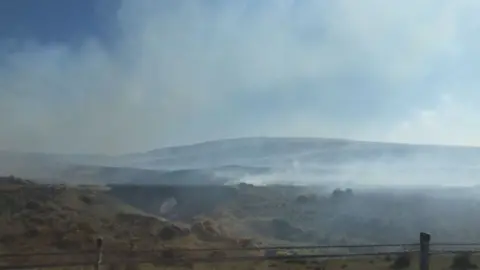 Henk Pieter Sterk
Henk Pieter SterkA new study into the ecological impact of wildfires on peatland is to begin in Scotland's Flow Country.
The peatbog, which stretches across Caithness and Sutherland, is the largest in Europe and is an import store of greenhouse gases.
The Fire Blanket project will examine the effects of a large blaze which burned for several days in May across an area of about 22 square miles.
Researchers said it offered a "unique opportunity" to fill gaps in knowledge.
They will look at the way vegetation and water quality changed during the fire and afterwards.
The 494,210-acre (200,000ha) expanse of the Flow Country, more than twice the size of Orkney, includes peatbog, lochs and bog pools.
Its unusual nature means it is currently being considered for World Heritage status.
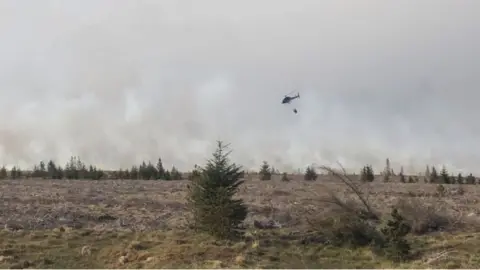 Henk Pieter Sterk
Henk Pieter SterkThe fire in May spread from the outskirts of Melvich on the north coast to Forsinard in the heart of the Flow Country.
The site being studied has been chosen because it already contains a vast amount of data readings from before the fire.
Comparative readings over the next 12 months will allow the researchers to chart the peatland's recovery.
Dr Roxane Andersen, from the Environmental Research Institute at the University of the Highlands and Islands, said it offered "a unique opportunity to fill important gaps in knowledge required to improve management of peatlands to minimise fire risk and maximise resilience".

What is the Flow Country?
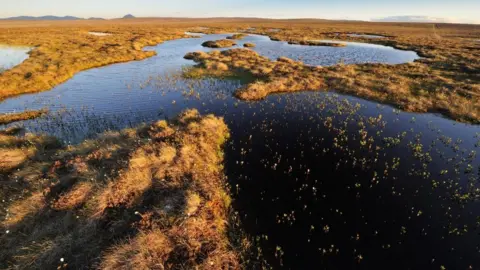 Lorne Gill/SNH
Lorne Gill/SNH- Bogs in the tundra-like landscape have been growing since the end of the last Ice Age more than 10,000 years ago
- The area's peat is up to 10m (33ft) deep
- Its soil stores about 100 million tonnes of carbon
- People live and work in the Flow Country and its communities include tiny Forsinard
- Wildlife found in the area include otters, deer and common scoter ducks. In the UK, common scoters breed at only a few locations, including the Flow Country and the lochs and and glens near Inverness

Changing climate
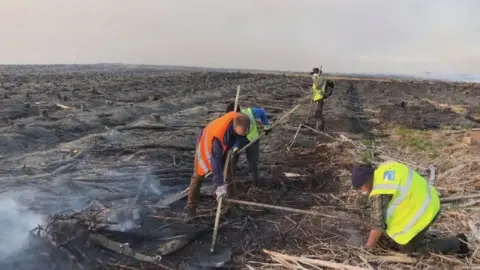 Henk Pieter Sterk
Henk Pieter SterkPeatlands perform an important function by soaking up carbon dioxide from the atmosphere and locking it away.
The small number of plant varieties which can grow in the wet conditions, such as sphagnum moss, do not rot away but form the layers of peat which is continually growing.
The wild habitat also promotes a wealth of biodiversity by encouraging a range of bird, animal and plant species.
Experts said extreme weather events, including wildfires, were likely to increase in frequency as a result of the changing climate.
Dr Andersen, from the University of the Highlands and Islands, said: "Understanding how land-use interacts with climate extremes in peatlands is essential to inform which management practices best maintain and enhance peatland carbon storage.
"However, this is notoriously challenging to achieve because climate extremes are rare and ephemeral. In addition, their effects can only be truly assessed where high-quality, ground-based observations pre-date an extreme event and where data from both impacted and similar control areas can be compared afterwards."
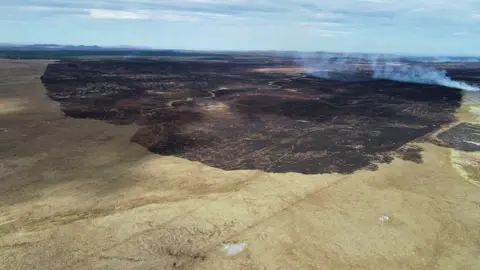 Paul Turner/RSPB Images
Paul Turner/RSPB ImagesShe said all of these conditions had come together in the recent Flow Country fire.
The damaged area is about 10 miles long with the peatland managed in different ways across the area.
Some sections contain tree plantations while others are partially restored.
The study will also look at the impact of the fire on the different styles of land management.
Graham Sullivan, uplands advisor with Scottish Natural Heritage, told BBC Scotland: "It was the biggest fire we had in Scotland this year and it was much bigger than fires we are used to seeing.
"They can cause huge damage. There are several things they can do. The first thing is to simply burn the plants and animals that can't move very quickly.
"It can also affect huge areas and the problem with that is you end up with a very uniform habitat type across the whole area, all at the same age, the same structure and that means you don't get the same variation in niches suitable for different plants and animals."
